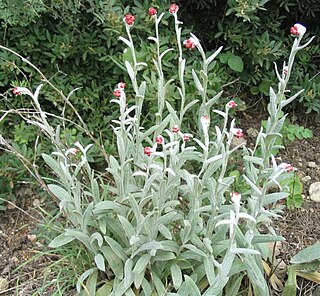
The family Asteraceae, alternatively Compositae, consists of over 32,000 known species of flowering plants in over 1,900 genera within the order Asterales. Commonly referred to as the aster, daisy, composite, or sunflower family, Compositae were first described in the year 1740. The number of species in Asteraceae is rivaled only by the Orchidaceae, and which is the larger family is unclear as the quantity of extant species in each family is unknown.

The genus Helichrysum consists of an estimated 600 species of flowering plants in the sunflower family (Asteraceae). The type species is Helichrysum orientale. They often go by the names everlasting, immortelle, and strawflower. The name is derived from the Greek words ἑλίσσω and χρῡσός.

Pallenis is a small genus of flowering plants in the tribe Inuleae within the family Asteraceae. The name is derived from palea (chaff), referring to the chaffy receptacle.
Harold Ernest Robinson was an American botanist and an entomologist.

The Gnaphalieae are a tribe of flowering plants in the family Asteraceae. It is most closely related to the tribes Anthemideae, Astereae, and Calenduleae.

Craspedia is a genus of flowering plants in the family Asteraceae commonly known as billy buttons and woollyheads. They are native to Australia and New Zealand where they grow in a variety of habitats from sea level to the Alps. The genus is found in every state of Australia except the Northern Territory. In New Zealand, Craspedia is found from East Cape on the North Island south to Stewart Island. It also occurs on Campbell Island and the Chatham Islands.

Gnaphalium is a genus of flowering plants in the sunflower family, commonly called cudweeds. They are widespread and common in temperate regions, although some are found on tropical mountains or in the subtropical regions of the world.
Humeocline is a genus of plants in the sunflower family, endemic to Madagascar.

Hesperevax is a small genus of flowering plants in the tribe Gnaphalieae of the family Asteraceae.

Anemocarpa is a genus of flowering plants in the family Asteraceae, endemic to Australia.

Podotheca is a genus of flowering plants in the pussy's-toes tribe (Gnaphalieae) within the Asteraceae. All species are endemic to Western Australia, except for Podotheca angustifolia which occurs across the south of Australia.

Argentipallium is a genus of flowering plants in the family Asteraceae. The genus, which is endemic to Australia, was first formally described in 1992 by Paul G. Wilson in the botanical journal Nutsyia.
Alatoseta is a genus of flowering plants in the daisy family, Asteraceae described as a genus in 1931.

Euchiton is a genus of flowering plants in the family Asteraceae. They are native to Australasia and the Pacific. Some have been introduced far outside their native ranges.

Pogonolepis is a genus of Australian plants in the tribe Gnaphalieae (pussy's-toes) within the daisy family Asteraceae.

Gamochaeta is a genus of flowering plants in the family Asteraceae. There has not always been agreement among botanists regarding its status as a recognized genus, but it has become more accepted in recent years. It currently includes many plants that previously belonged in genus Gnaphalium. Like many species of Gnaphalium, many Gamochaeta are called cudweeds or everlastings.
Argyrotegium is a genus of plants in the family Asteraceae, native to Australia and New Zealand.

Panaetia, a genus in the Asteraceae (daisy) family, was first described by Henri Cassini in 1829 It is considered by Plants of the World online and the Global Compositae Database to be a synonym of Podolepis Labil,. while GBIF states it as "doubtful". However, in 2021, the Western Australian Herbarium accepted Jeffery Jeanes new circumscription of the genus, together with two species of Panaetia as being found in Western Australia: Panaetia lessonii, and Panaetia tepperi. Jeanes distinguished Panaetia from the genera, Podolepis, Siemssenia and Walshia, using the following characters:
- the outer florets are all tubular; and
- the cypselas are minutely tuberculate and lack long finger-like papillae.
Haptotrichion is a genus of Australian plants in the tribe Gnaphalieae within the family Asteraceae.
Paul Graham Wilson is an Australian botanist. He has been a most prolific contributor to the journal Nuytsia, contributing to the first issue in 1970 and to the 12th volume in 1998, which was dedicated to him for his contributions to plant taxonomy and to celebrate his 70th birthday. Since his retirement from the Western Australian Herbarium in 1993, he has helped to maintain a comprehensive census of the flora of Western Australia.














